Food for you and your baby: Easy meals that you both can eat!
Tired of making one meal for yourself and another for your baby? There’s no need to give yourself extra work with these family meals that can be tweaked for little tummies before being served up for big tummies!
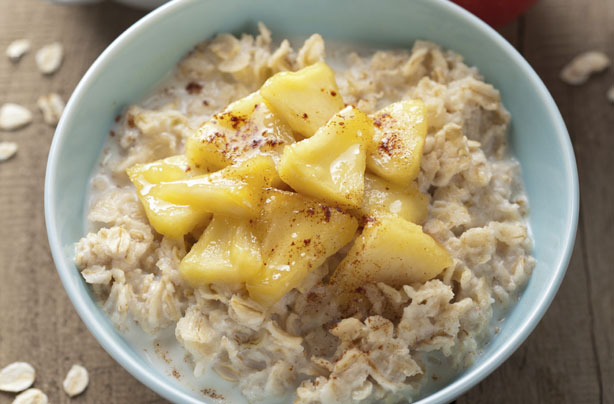

Tired of making one meal for yourself and another for your baby? There’s no need to give yourself extra work with these family meals that can be tweaked for little tummies before being served up for big tummies!
Family meals to feed your baby and you
Tired of making one meal for yourself and another for your baby? There’s no need to give yourself extra work with these family meals that can be tweaked for little tummies before being served up for you and the rest of the adult family.
With recipes for breakfast, lunch, dinner and dessert, there are meals for any time of the day to suit both you and your baby. Think comfort food classics like leek and potato soup, lasagne and chicken casserole which can be easily prepared and transformed into meals for you both.
With just a few substitutes or cuts here and there and a little pureeing, you can make simple, healthy and hearty baby food that the shop bought stuff simply can’t compete with.
Click through to see all the recipes in this collection…
Breakfast: Porridge

There’s no reason why you can’t all have the same breakfast as a family, once your baby starts to eat solids. Making your porridge from scratch for both you and the baby will mean cutting out the sugar and salt often found in packet mixes and you can flavour it anyway you like.
Parenting advice, hot topics, best buys and family finance tips delivered straight to your inbox.
How to prepare for your baby: Blitz oats in your own food processor to make a fine powder, ready to make into your porridge. With a recipe like our apple and cinnamon porridge, you can simply puree the apple, honey and cinnamon mixture till smooth and mix through the porridge for added flavour for both you and the little one. If your baby has just started on solids it's best to use oatmeal so the texture is as smooth as possible.
Why it’s good for them: A good source of fibre, oats will aid your baby’s digestion. Oats are also much easier to digest than many other grains for babies’ little tummies and are slowly absorbed into the bloodstream, keeping blood sugar spikes at bay and helping keep hearts healthy too.
Get the recipe for you: Apple and cinnamon porridge
Breakfast: Smoothie
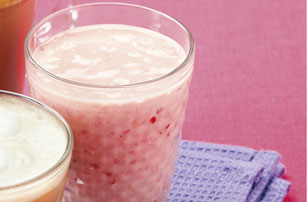
Next time you’re making a smoothie keep a little of it back for your child’s breakfast. There’s no need to do much differently if you are making a healthy recipe like this fruity breakfast smoothie, sweetened with bananas and using plenty of healthy yogurt.
How to prepare for your baby: If your baby is under 12 months, we would recommend leaving out the milk and you will be able to spoon feed it easily. Try different combinations of fruit to see what your baby prefers. They’ll love the smooth creamy, fruity taste and you’ll be happy knowing they are getting plenty of vitamins and minerals at the start to the day.
Why it’s good for them: A plain, full-fat yogurt is full of calcium, healthy bacteria (which helps break down the lactose making yogurt a better first food than milk for babies) and protein. All of these, as well as plenty of vitamins and minerals, will support your little one’s development across the board.
Get the recipe for you:
Banana, raspberry and yogurt breakfast smoothie
Lunch: Soup
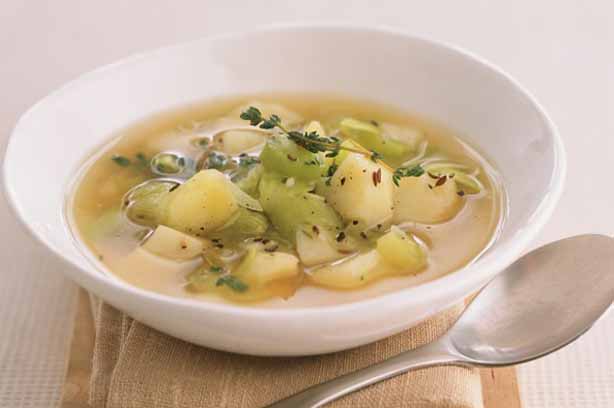
Fancy a warming lunch for you and baby? Soup makes an ideal first food when made with low-salt stock and plenty of healthy veg. All you have to do is make up the soup as you would for you and then blitz the rest of it in a food blender until smooth for baby. Make sure it's not too hot when serving.
How to prepare for your baby: To make sure your soup is as healthy as possible you can make your own stock by simmering chicken bones in water for an hour or so and straining. With our classic leek and potato soup, we recommend leaving out the cream, nutmeg and obviously the garnish too - keeping the recipe nice and simple so it’s gentle on your baby’s digestion.
Why it’s good for them: Leeks are a really good source of vitamin A which helps eyes stay healthy and immune systems stay strong.
Get the recipe for you:
Lunch: Baked potato
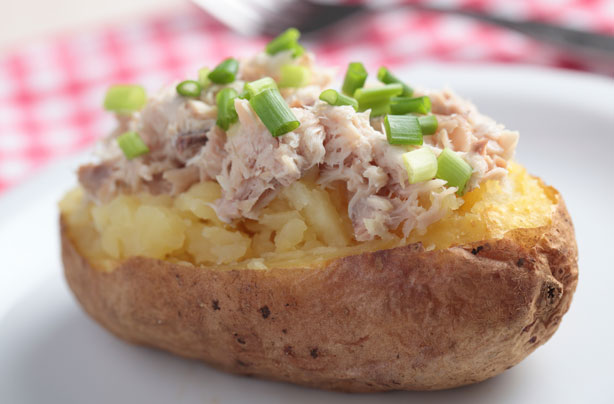
This tasty meal is a great mid-week dinner, taking very little effort. You can try different fillings too if you fancy a change from tuna, try chicken, salmon or a mild cheese - whichever suits you and your baby's taste buds.
How to prepare for your baby: Make the potato as you would normally for yourself. When your potato is cooked, remove the flesh and puree with the tuna and spring onion, if you think your baby will like it. We would leave out the typically salt-heavy mayonnaise, sea salt and the butter to keep everything fresh and healthy.
Why it’s good for them: Fish is a lean source of protein for little people and introducing it early on may give them a taste for it as they grow to help them towards a healthy and varied diet.
Get the recipe for you:
Baked potato with tuna and spring onion
Dinner: Fish pie

With only a few basic ingredients, this fish pie is a tasty meal for everyone in the family from the little ones right up to mum and dad. Because of the milky sauce we would only introduce this from nine to 12 months(ish) but you can check with your doctor or health visitor if you think your baby would enjoy it earlier, all babies develop at different times after all.
How to prepare for your baby: To keep the salt content low we would recommend leaving out the smoked haddock. If you fancy the added flavour yourself you can easily make your baby a mini one in a little dish. Once cooked, serve your portion up and then leave to cool a little for baby and then puree until smooth and serve.
Why it’s good for them: Low-in-fat and a good source of protein, white fish is a gentle ingredient to introduce to your baby early on. If you fancy introducing fish from six months, try pureeing with plain boiled potatoes before moving onto full-blown fish pie.
Get the recipe for you: Fish pie
Dinner: Cottage pie
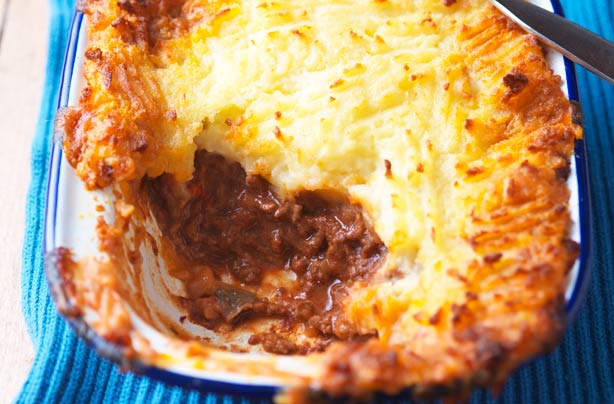
Cottage pie is one of those dishes which is better made in bulk. If you're planning on making this for your baby and the rest of the family, you could dish out everyone's portions and then pop your baby's portion into a blender or mash with a masher until smooth. That way everyone can sit at the table together and eat at the same time.
How to prepare for your baby: If you are planning to make one big dish of cottage pie to share with your baby then remember to use low-salt stock and we would leave out the Worcestershire sauce too. Leaving out the sauce won’t alter the taste too much but it’ll lower the acidity levels making it better for your baby's tummy. Leave out the butter and salt in the mashed potatoes to make this dish even healthier.
Once your dinner is cooked, leave a little out to cool down, blend and serve to baby when at a good temperature. Alternatively, you could freeze for another day in little freezer bags or ice cube trays.
Why it’s good for them: Our classic cottage pie recipe sneaks in lots of lovely veggies to keep you and your little one healthy. With mushrooms, tomatoes and carrots, there are plenty of vitamins and minerals to support your baby’s development. You could even add other vegetables and less meat if you’d prefer.
Get the recipe for you: Cottage pie
Dinner: Roast chicken

Fancy a Sunday lunch but don't know what to feed your little one? They'll love the soft roast chicken and pureed vegetables like peas or carrots - they make a delicious healthy combination that only need to be blitzed down in a food processor to serve to your baby.
How to prepare for your baby: There’s very little you need to do with a lovely roast chicken to make it suitable for your baby. Simply roast in its natural juices for you and the family and then cut off some of the meat to puree for baby once cooked. You can add any veggies you’re having too, like carrots, peas or potatoes to give them a little healthy boost.
Why it’s good for them: Because it is one of the most easily digested meats, chicken is a great way to get your baby beyond simple fruit and veg purees. High in protein and iron, it will keep their little tummies full and their minds active.
Get the recipe for you:
Dinner: Spaghetti Bolognese
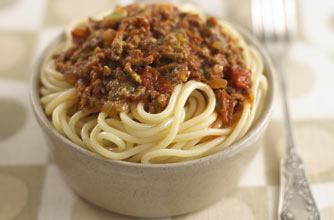
This family classic can be a tasty progression from pureed fruits and veggies once your baby starts welcoming different flavours and textures. Before serving the Bolognese on the spaghetti, portion out some of the sauce for your baby and leave to one side to cool.
How to prepare for your baby: Try and get the leanest beef possible to make this dish as easily digestible as possible. Make the sauce without the salty Worcestershire sauce or ketchup to keep it gentle on your baby’s tummy. Puree the sauce once it’s cooked, or blitz roughly if your baby is a little older.
Pasta is typically introduced to a baby from eight months. It's recommended that you only serve a very small portion in case of wheat allergies. You can blitz the spaghetti in a blender with the sauce or swap the spaghetti for a smaller, softer type of pasta like orzo - the choice is yours.
Why it’s good for them: This recipe will give your baby a good source of iron which is sometimes hard to get into young children. Along with vitamin B and protein, beef is a filling and nutritional ingredient to add to your baby’s diet.
Get the full recipe: Spaghetti Bolognese
Dinner: Chicken curry
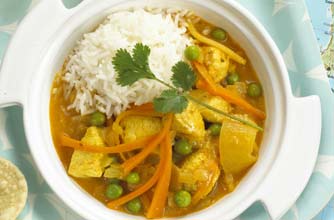
This child-friendly recipe has been designed by infant expert Annabel Karmel so needs very little tweaking to make it perfect for your baby's digestive system. If you’re making this for your baby don’t be put off by its children’s food’ status, this curry is packed with flavour and sweetness from the fruit which makes it a delicious combo for mums too!
How to prepare for your baby: Make sure to use low-salt stock and try not to add any extra seasoning as you don’t want your baby to get used to the taste of salt in their food, it can sometimes lead to little ones refusing to eat anything that doesn’t have it in from then on. Make the curry as you would for you and then set a portion aside for baby, leave to cool and then blitz until smooth. At this point you can add more spice to your portion of curry, if you fancy giving it a little kick.
Why it’s good for them: The protein from the chicken will help aid your baby’s general development while the vitamins and minerals from apples, carrots, peas and tomatoes give them a tasty treat that’s packed with nutrients. Some experts suggest that introducing a variety of spices and flavours will help to make sure you don’t end up with a fussy eater later on.
Get the recipe for you:
Annabel Karmel’s fruity chicken curry
Dinner: Chicken casserole
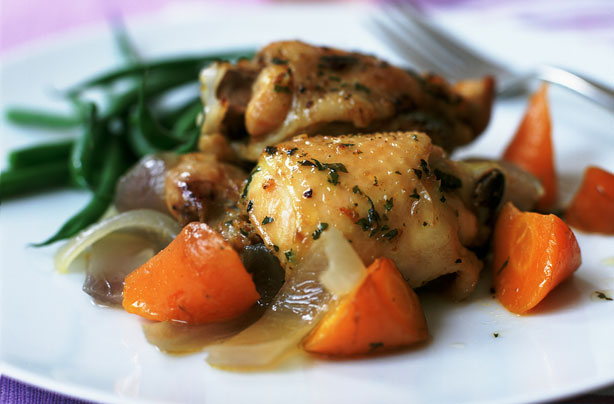
The comforting flavours of chicken and root vegetables are perfect as your baby starts to look for foods beyond fruit, when they’re a little older than six months. A casserole is the ideal meal for both you and your baby as it can be left to cook for hours making the meat succulent and the veggies tender so it's quick to prepare for baby.
How to prepare for your baby: Leave out the white wine and rich bacon, and make sure to swap the stock for a low-salt version and that’s about all you need to do before pureeing or mashing for your little one. If your little one is under a year, you might want to swap the celery for a softer vegetable like parsnip or broccoli as celery can be hard to puree, leaving stringy bits.
Why it’s good for them: The protein in the chicken will help your baby’s overall development and if you use a homemade chicken stock you’ll pack in even more nutrients.
Get the full recipe: Chicken casserole
Dinner: Chilli con carne
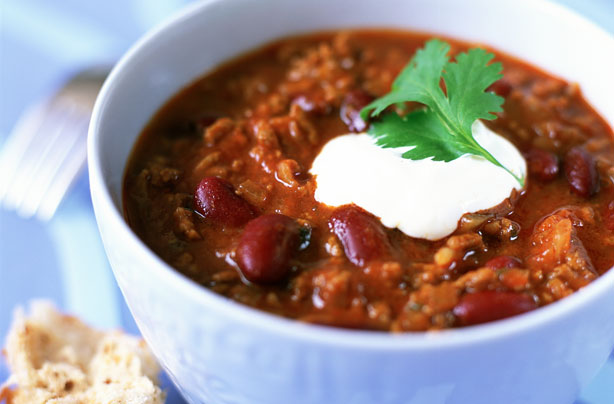
Introducing new flavours like herbs and spices to your baby from around eight months will help expand their palette, hopefully making them less of a fussy toddler! Chilli is packed with tasty flavours and is easy to alter for a little ones' taste buds.
How to prepare for your baby: Simply leave out the wine, chilli, Worcestershire sauce and make sure your stock is a low-salt version. Make sure to use lean beef mince to make it easy to digest. You can make it like this for the whole family and simply add more seasoning, the Worcestershire sauce and chilli after you’ve removed your little one’s portion. Puree or blitz to make it easier to swallow and serve.
Why it’s good for them: Beans are a great, lean source of protein to introduce to your baby from somewhere between eight to ten months roughly. Their digestive systems will have become stronger at this point and it’ll make it easier for them to break the beans down. The fibre found in beans will also aid their digestive systems once they’re ready to start eating them.
Get the recipe for you: Chilli con carne
Dinner: Vegetable lasagne
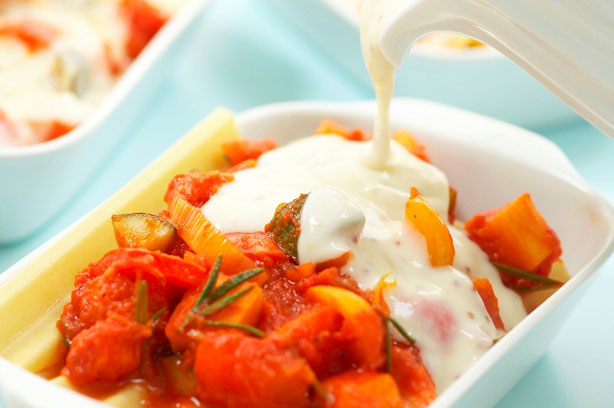
It's good to have a vegetarian meal a few times a week to make sure that your baby's diet is varied with nutrients and this veggie lasagne is packed full of goodness and perfect for making for both you and your baby too.
How to prepare for your baby: Mustard can sometimes cause allergies so make sure your baby isn’t allergic before adding or leave out completely if you’re not sure. Other than that small sacrifice, this nutritious dish can be made the normal way, again just making sure you are using a low-salt stock or even water instead of powders or gels which are loaded with it. Puree or blitz once cooked, leave to cool a little and you’re ready to serve.
Why it’s good for them: With four different vegetables and an added bonus with the homemade tomato sauce, this veggie lasagne is a complex mix of all the best vitamins and minerals. The beta-carotene in the carrots and butternut squash will provide your baby with plenty of antioxidants and is broken down into vitamin A too.
Get the recipe for you: Vegetable lasagne
Dessert: Fruit salad
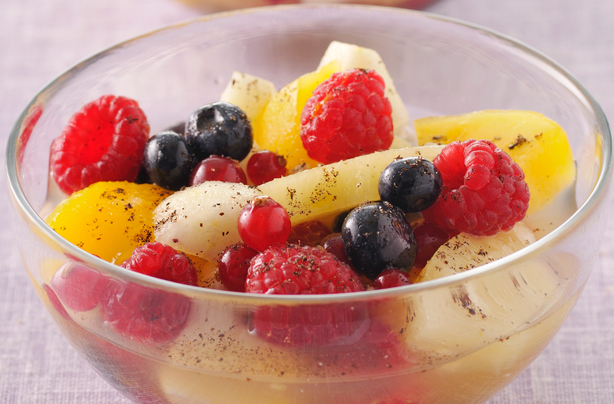
Give your baby a fresh, fruity pudding which will give them a sweet treat without all that typical sugar which comes in desserts. It really doesn't take much to make this dessert, and you don't have to change much either to adjust the recipe for both you and your baby.
How to prepare for your baby: Sweeten this tasty fruit salad with a touch of honey instead of sugar or leave out the sweetener altogether if preferred. We wouldn’t change anything else in this tasty recipe, the light spices will give the fruit salad warmth and will introduce a new flavour to your little one too. Again, decide whether you’d like to mash, blitz or puree this dish and serve up.
Why it’s good for them: Including a range of colours is a good indication of a variety of vitamin and minerals in fresh fruit and veggies. This simple dessert for instance contains vitamin C from pears, vitamin A from peaches and antioxidants from blueberries.
Get the recipe for you: Fruit salad
Dessert: Rice pudding
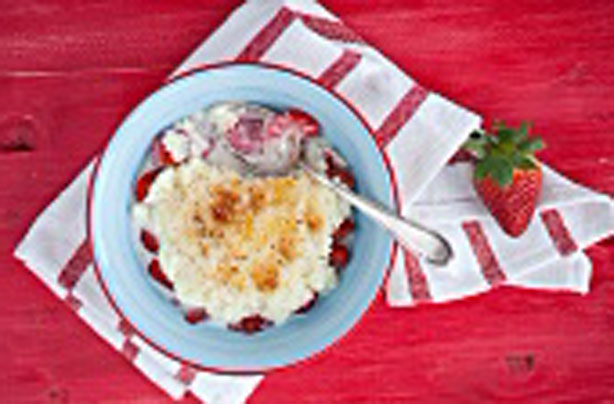
Rice pudding is a classic pud which is perfect for a little treat every now and then for both you and your baby. Once cooked, rice pudding becomes soft and pretty smooth so there's really nothing to change drastically in the method.
How to prepare for your baby: We don't think it's a very good idea to give little babies lots of sugar so we would suggest replacing the sugar with honey or even sugar-free jam, simply add a little and try before serving to see whether you need a little bit extra. Because honey and jam are so soft it will melt in easily at the end to make it however sweet you like.
Why it’s good for them: There is very little nutritional benefit in this pud apart from a good dose of calcium from the milk! It is pudding though so we think it’s ok for a treat every now and then.
Get the recipe for you: Rice pudding
Where to next?
- See all our baby food recipes
- 10 one-ingredient baby food recipes
- How to encourage your baby to eat

Rosie is an experienced food and drinks journalist who has spent over a decade writing about restaurants, cookery, and foodie products. Previously Content Editor at Goodto.com and Digital Food Editor on Woman&Home, Rosie is well used to covering everything from food news through to taste tests. Now, as well as heading up the team at SquareMeal - the UK's leading guide to restaurants and bars - she also runs a wedding floristry business in Scotland called Lavender and Rose.